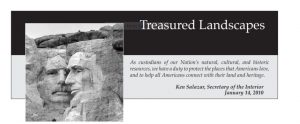In late 2009, then-Secretary of the Interior Ken Salazar announced a new conservation program, the “Treasured Landscape Initiative.” Based on Salazar’s experience in Colorado, the effort sought to promote collaboration between public lands managers and private property owners on a large geographic scale. Embraced by many in the preservation and environmental protection communities, the idea generated a less enthusiastic response among some critics of federal land management, especially in the West. (See an earlier article we ran on Secretary Salazar’s legacy here)
A series of listening sessions to promote the Treasured Landscape approach were held across the country with different regions applying for recognition and support. I attended one such meeting in Annapolis, MD. After leaving the well-attended gathering, I wondered how Salazar’s Treasured Landscapes vision would transform the conservation of large landscapes. Would it lead to changes in funding, land ownership, and the centrality of partnerships?
A decade later, the term “treasured landscapes” is rarely used. Many of the principles driving Salazar and program supporters remain popular, but the formal effort itself received little visible support from the Secretary’s successors. Why did the initiative disappear so quickly?

As I thought about the fate of the Treasured Landscape Initiative, it made me wonder why some programs or ideas seem to gain traction and staying power, while others fade from view. The Land and Water Conservation Fund, for example, has been a relatively durable initiative –albeit one that suffers from chronic under-funding and now, after more than fifty years, legislative uncertainty.
I would argue that at least part of the LWCF’s longevity lies in its origins as a recommendation of the Outdoor Recreation Resources Review Commission (ORRRC). The ORRRC was bi-partisan and importantly enjoyed support from the legislative and executive branches. Its final recommendations, though clearly supported by Secretary Stewart Udall, also had the backing of members of Congress and a broad coalition of non-governmental organizations, ranging from labor unions, to hunting and fishing groups, some businesses, and conservation organizations. In other words, in 1962, when the ORRRC issued its final report calling for a grant program aimed at land conservation, it was not seen as an “Udall” product. Also, important, of course, were the facts that the LWCF had a legislative mandate and a funding source.
Another factor that can influence program longevity is having origins (and thus a base of support) within a particular agency or bureau. The Pennsylvania Heritage Areas (initially called heritage parks) is an example of this phenomenon. The concept of heritage parks did not originate in Pennsylvania, but , during the 1980s and 1990s, savvy officials within a variety of Pennsylvania state agencies, including the now defunct Department of Community Affairs, championed the idea and led the effort to establish a formal program. They cultivated legislative and community partners (who, of course, were also essential!), while maintaining an active role over management. This approach, where support comes from within an established bureaucracy, can also be effective in ensuring a program’s survival, even during especially tough budget cycles.
What do you see as the keys to program sustainability? Is it important that an effort, especially one that identifies or labels landscapes (to create a new system, for example), be able to survive over time? Please share your thoughts.



2 Responses
An interesting piece on the longevity of the LWCF. It would not have come to pass without the policy and research footing of the ORRRC. It certainly helped to have a Rockefeller as chair. Udall primed the pump, as it were, by creating the BOR before the LWCF itself was authorized.
Of course as with so many programs, LWCF was originally supposed to sunset after 25 years. By then of course, states and local communities had become dependent on the funding.
With its focus on near-urban recreation, I’ve often wondered about the relationship between the LWCF and the civil rights disturbances of the 1960s.
Another example might be NEEL (National Environmental Education Landmarks), a short lived Hartzog era program that tried to link NPS with non-park environmental educational properties.
I think another critical piece is whether an initiative provides federal funding to local or state folks. If it does, then a constituency develops that helps support continued funding and survival of the program. I think LWCF exemplifies that phenomenon.